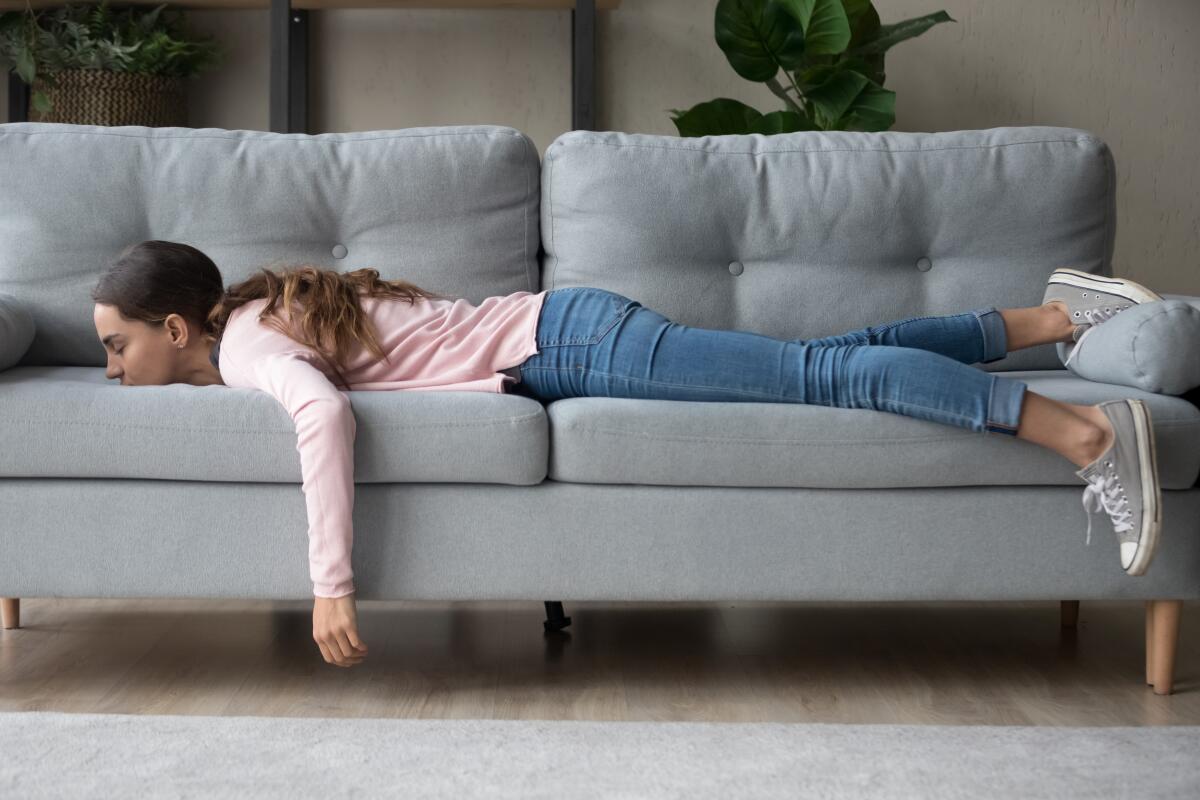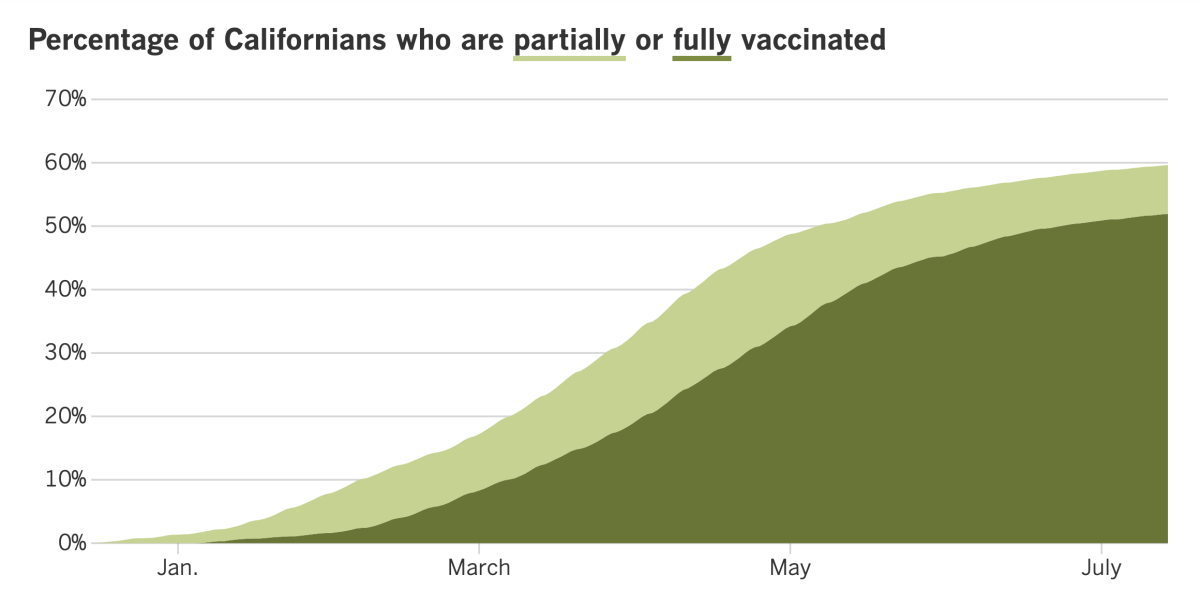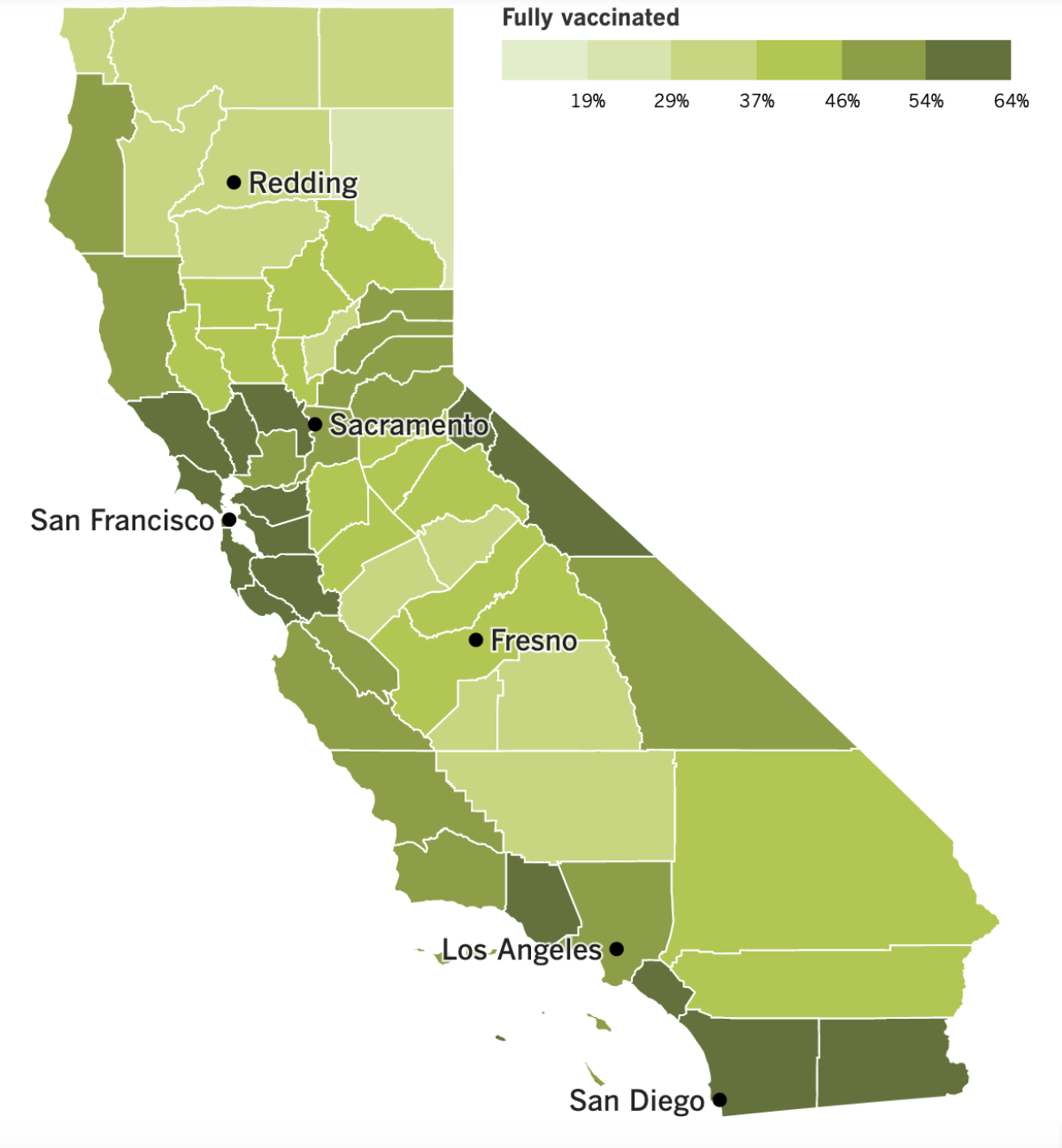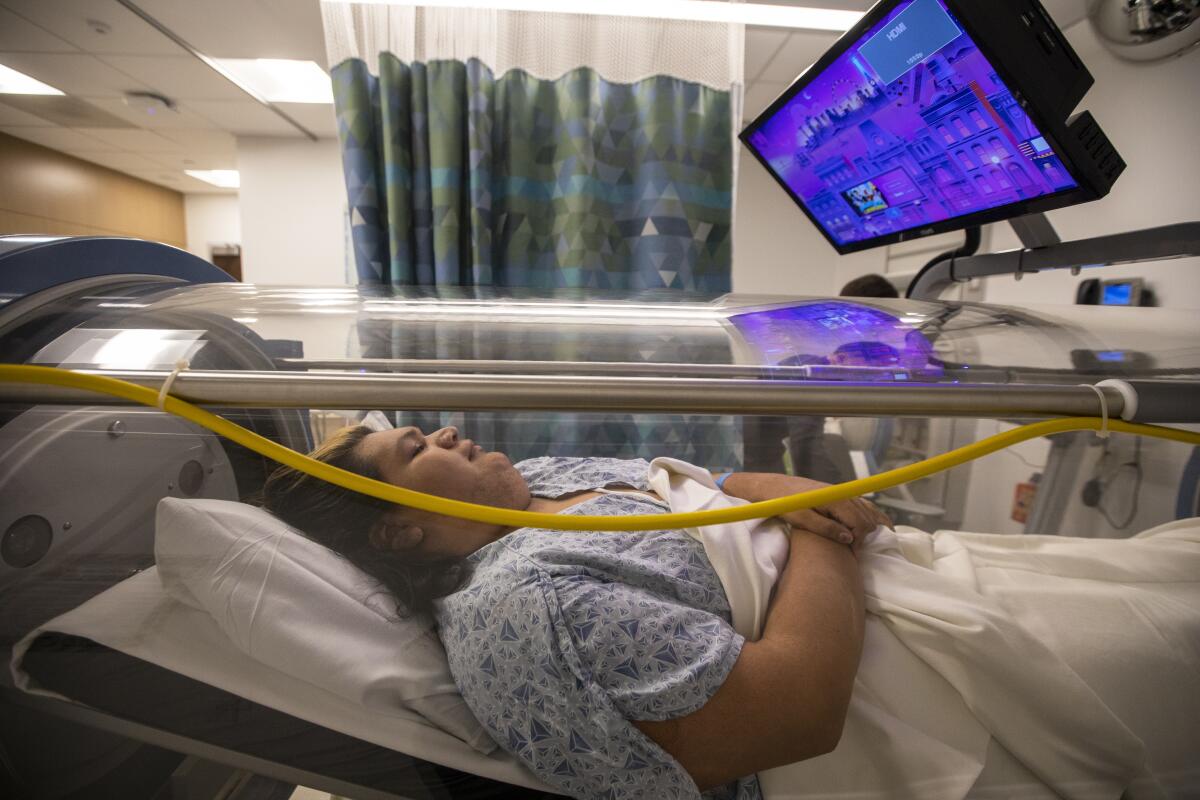Coronavirus Today: The Delta variant, American-style
Good evening. I’m Karen Kaplan, and it’s Friday, July 16. Here’s what’s happening with the coronavirus in California and beyond.
The Delta variant was first detected in Greene County, Mo., in May. At the time, COVID-19 hospitalizations there had been hovering around 34. But by June 21, there were 155 patients in the county’s hospitals, and by July 8, that number had climbed to 192. That includes 70 patients being treated in critical care units.
The county with a population of about 297,000 people reported 19 COVID-19 deaths in June, and health officials expect that number to double or triple in July.
“We are just being inundated with COVID cases,” Kendra Findley, the county’s administrator of community health and epidemiology, told my colleague Melissa Healy. All of those cases were caused by the Delta variant.
Across the country, about 58% of all new coronavirus infections in the U.S. involve Delta. It spreads twice as readily as the original virus that sparked the pandemic and is 50% more transmissible than the Alpha variant, which until recently was the dominant strain in the U.S.
But in places like Greene County, Delta’s transmissibility isn’t the only thing it has going for it. The variant is also taking advantage of the population’s lack of immunity. Only 45% of Greene County residents are at least partially vaccinated, and 40% are fully vaccinated.
In fact, counties with vaccination rates below 40% account for 93% of the counties with the highest rates of new infections, according to Dr. Rochelle Walensky, director of the CDC. Many of these counties are strongholds of the Delta variant, she added.
In Galveston County, Texas, about 45% of residents are fully vaccinated. But that number has scarcely budged in months — a fact that frustrates Dr. Philip Keiser, the county’s chief health officer.
“I’d say there’s hesitancy and I’d use another word — obstinance,” he said. “There’s this attitude, ‘You can’t make me!’”
Some residents even objected when the county’s data dashboard began reporting the vaccination status of those who were hospitalized or died of COVID-19. (With rare exceptions, virtually all are unvaccinated.)
“‘You’re just trying to scare us!’ they said. I said, ‘Nope, just reporting the facts,’” Keiser said.
Those sentiments have been fueled by misinformation about the vaccines, much of it spreading on social media platforms like Facebook and on TV talk shows hosted by conservatives like Laura Ingraham and Tucker Carlson.
President Biden called them out Friday for leaving millions of people unnecessarily vulnerable to the Delta variant, my colleagues Chris Megerian and Sasha Hupka report.
“They’re killing people,” Biden said as he left the White House for Camp David. “The only pandemic we have is among the unvaccinated. And they’re killing people.”
Jeff Zients, who leads Biden’s task force on the pandemic response, put it this way: “Each COVID-19 death is tragic. And those happening now are even more tragic because they are preventable.”
Polls show that Republicans are much less inclined to get vaccinated than Democrats and independents, and data from the Kaiser Family Foundation show that the gap between red and blue counties is widening. As of April 22, 22.8% of residents in counties that voted for Biden were fully vaccinated, compared to 20.6% in counties that voted for Trump. By July 6, 44.7% of people in pro-Biden counties were vaccinated versus 35% in those that favored Trump.
The situation prompted Surgeon General Dr. Vivek Murthy to issue a formal health advisory this week, warning that misinformation around COVID-19 vaccines poses an “imminent and insidious threat.”
Advisories like this are typically issued to warn about the dangers of tobacco use or the opioid epidemic; Murthy’s bulletin was the first to target misinformation.
“Simply put, health misinformation has cost us lives,” he said.
By the numbers
California cases, deaths and vaccinations as of 5:11 p.m. Friday:

Track California’s coronavirus spread and vaccination efforts — including the latest numbers and how they break down — with our graphics.
Will we ever get a good night’s sleep again?
We are quite literally losing sleep over the coronavirus.
Survey results from the American Academy of Sleep Medicine suggest that more than half of us have experienced sleep problems since the start of the pandemic. That includes 54% of women and 59% of men.
There is no region of the country where soundsleepers are in the majority. The best showing was in the South, where 48% of those surveyed said the pandemic hadn’t affected their slumber. Only 37% of those in the Northeast could say the same.
You might think older Americans — who are worse sleepers to start with and who might reasonably be losing sleep over the fact that they’re the most vulnerable to serious or fatal cases of COVID-19 — would have it the worst. But the sleep medicine experts found the opposite: Only 32% of those 65 and older said their sleep got worse during the pandemic.
The ones who’ve actually lost the most Zs are adults between the ages of 35 and 44 — 70% of them said their sleep has suffered. So did 60% of people ages 45 to 64.
Overall, two-thirds of us seem to have trouble falling asleep and staying asleep since the coronavirus arrived. About half are getting less sleep per night, and half say our sleep is less restful.
The problem is bad enough to have not one but two names. The sleep medicine academy calls it “COVID-somnia.” Sleep experts also call it “coronasomnia.”
Colulmnist David Lazarus wrote about the problem this week. Unfortunately, some of the sleep experts he spoke to said coronasomnia could outlast the pandemic.
Donn Posner, an expert in behavioral sleep medicine who teaches at Stanford, said we should be prepared for “the epidemic of chronic insomnia that will follow the pandemic. ... Stress can lead to chronic insomnia, and chronic insomnia can take on a life of its own.”
Dr. Rajkumar Dasgupta, a sleep specialist at USC, said we’ll have to work to undo our night owl habits.
“Good sleep is about structure,” he told Lazarus. “People are going to have to reset their circadian rhythms, which is not easy.”

The pandemic’s not over yet, but if you’d like to get a jump on things, the experts advise you to wake up at the same time every day. If this makes you feel jet-lagged at first, resist the urge to nap.
Avoid caffeine, alcohol and nicotine before bed. Ditto large meals, exercise and gadgets that emit light or sound. If you keep your devices out of your bedroom, they’ll be easier to resist.
If you still find yourself waking up a lot at night, try a later bedtime so your hours of sleep will be compressed into a continuous cycle.
Establishing better sleep hygiene isn’t easy, but it can be done.
“I don’t think we’re forever doomed,” said Dr. Ronald Chervin, director of the Sleep Disorders Centers at the University of Michigan.
California’s vaccination progress


See the latest on California’s vaccination progress with our tracker.
Consider subscribing to the Los Angeles Times
Your support helps us deliver the news that matters most. Become a subscriber.
In other news ...
The Delta variant isn’t causing as much trouble in Los Angeles County (where 59.8% of residents are at least partially vaccinated and 52.3% are fully vaccinated) as it is elsewhere — and health officials want to keep it that way. That’s why they’ve decided to make face masks mandatory in indoor public spaces, starting at 11:59 p.m. Saturday.
The rule will apply to everyone regardless of vaccination status.
“This is an all-hands-on-deck moment,” said Dr. Muntu Davis, the county’s health officer. “We’re not where we need to be for the millions at risk of infection here in Los Angeles County, and waiting to do something will be too late given what we’re seeing now.”
Long Beach, which has its own public health department, has opted to align with L.A. County’s health order. Pasadena, which also operates its own public health department, currently recommends face masks for everyone in indoor public settings and is “reviewing options for a mandate,” according to a spokesperson.
L.A. County’s health order puts it further at odds with both the California Department of Public Health and the CDC. The state and federal agencies maintain that face coverings aren’t necessary for vaccinated people because they’re protected against the coronavirus.
But the county’s order isn’t about protecting people who are vaccinated — it’s about protecting those who aren’t, my colleagues Luke Money and Rong-Gong Lin II write.
Health officials suspect that some unvaccinated people are going maskless indoors, even though they’re required to cover up. The easiest way to change that is to require face masks for everyone, Davis said.
There’s no denying that the health order removes one of the advantages of getting vaccinated. But it’s also one of the less draconian measures the county could have reached for. Requiring people to wear masks indoors won’t interrupt business operations — and if it works, it will allow them to remain open without restrictions on capacity or anything else.
And if it doesn’t work?
“Anything is on the table if things continue to get worse, which is why we want to take action now,” Davis said.
A few other counties are starting to see things the same way. Both Sacramento and Yolo counties are now recommending that all residents, wear masks indoors, regardless of their vaccination status.
County health departments aren’t the only ones grappling with face mask requirements. The issue is top of mind for school officials who will be welcoming students back to campus in a matter of weeks.
After some initial confusion, the state issued a mask mandate for the coming school year but opted to let local educators decide how to enforce it — or whether to enforce it at all.
Up north in Glenn County, Hamilton Unified Supt. Jeremy Powell indicated that he is in the latter camp. “As a public educational leader, I can not continue enforcing policies not only I do not support but rather feel are bordering on child abuse,” he tweeted.
Nicole Newman, superintendent of the Wheatland Union High School District north of Sacramento, has reservations too. A face mask requirement would serve as “a constant reminder to the students of the fear and uncertainty they experienced during the peak of the pandemic,” she wrote in a letter to the state.
In Southern California, the L.A. Unified School District intends to enforce the mask mandate for students who want to be on campus. Last school year, administrators didn’t hesitate to send home students who refused to submit to a coronavirus test.
And in San Juan Capistrano, the Capistrano Union School District intends to require masks indoors but not outdoors. Students will get three or four chances to comply before they’re reassigned to remote instruction.
Families hoping to squeeze in a vacation before the school year starts are being asked to avoid travel to Nevada, Florida or other states with high coronavirus transmission rates. The request was made by Davis during a briefing to the L.A. County Board of Supervisors.
In higher education, the University of California said it would require COVID-19 vaccinations for all students, faculty and others before the fall term begins. The announcement makes UC the nation’s largest public university system to mandate the vaccines even though they don’t have full federal approval.
The California State University system is still hashing out its requirements but currently plans to hold off on a mandate until the U.S. Food and Drug Administration gives full approval to at least one of the vaccines. The Los Angeles Community College District also is encouraging, but not requiring vaccinations for students, faculty and staff.
Differences of opinion on vaccine mandates are evident in colleges and universities across the country. More than 580 institutions have announced vaccine mandates, including USC, Caltech, Stanford, Occidental, Chapman, Pepperdine and the Claremont Colleges. But UC is one of the few public university systems to opt for a mandate even though the vaccines remain under emergency use authorization.
Speaking of vaccines, I have a mistake to correct: In the last edition of this newsletter, I wrote that nearly 3.5 million doses of COVID-19 vaccine had been administered worldwide. I should have written “billion” instead of “million.”
Finally, the nation’s vaccination campaign has a new ally: Pop star Olivia Rodrigo.
The singer, who currently has the No. 2 song on Billboard’s Hot 100, met with Biden and his senior medical advisory, Dr. Anthony Fauci, this week to help convince Americans that getting vaccinated is “good 4 u.” She recorded a series of public service announcements outlining the benefits of the shots and the risks people run by skipping them.
One video has Rodrigo standing next to Biden in the Oval Office while the president urged people between the ages of 16 and 25 to get their shots. In another spot, Rodrigo sits with Fauci while they read tweets about the vaccine — a public health version of Jimmy Kimmel’s “Mean Tweets” schtick.
Rodrigo is merely the latest celebrity to team up with Fauci on vaccinations. The head of the National Institute of Allergy and Infectious Diseases has previously created TikTok videos with actor Jennifer Garner and “Dance Moms” alumni Mackenzie Ziegler and Nia Sioux.
Your questions answered
Today’s question comes from readers who want to know: Am I eligible for California’s new stimulus money?
Odds are, the answer is yes.
Two-thirds of Californians are expected to qualify for a check from the second phase of the Golden State Stimulus, which was approved by Gov. Gavin Newsom on Monday. It’s designed to help low- and middle-income Californians who are still struggling to recover from the effects of the lockdowns and other restrictions necessitated by the pandemic.
My colleague Madalyn Amato breaks down who is eligible for the checks, which come in amounts of $500, $600, $1,000 and $1,100.
There’s a lengthy list of requirements. On the income front, you have to have wages of $75,000 or less and a California adjusted gross income between $1 and $75,000.
On the tax front, you’ll need to file your 2020 return by Oct. 15 and not be eligible to be claimed as a dependent by anyone else.
On the residency front, you’ll have to have lived in California for more than half of 2020, and you must be living in the state when your check is issued.
The smaller checks will go to people who qualified for the first stimulus, and the larger checks will go for those who are only eligible for this one. The exact amount depends on whether you claimed a dependent on your 2020 taxes and a few other things.
If you don’t qualify for the new stimulus, you might still be eligible for the first one — and it’s not too late to apply. Check out Amato’s story to see whether this applies to you.
We want to hear from you. Email us your coronavirus questions, and we’ll do our best to answer them. Wondering if your question’s already been answered? Check out our archive here.
The pandemic in pictures

This is Sandy Vasquez, a transgender woman who lives in South Los Angeles. Her mother Reyna and her step-father Jose are determined to protect her until she finds her own safe place. They know that people like their daughter are beaten and killed in Mexico, their homeland. Even in California, Sandy was bullied by her classmates and humiliated by her teachers.
In recent years, Sandy had starting to feel comfortable going out to parties with cousins and friends. Reyna and Jose were optimistic that she’d find a job, even a partner who loved her.
Those hopes were battered by the pandemic. The family caught COVID-19 in December, and mortality has haunted them ever since. One dreaded question is never far from their minds: What will become of Sandy when Reyna and Jose are gone?
This moving story of love and sacrifice will stay with you.
Resources
Need a vaccine? Sign up for email updates, and make an appointment where you live: City of Los Angeles | Los Angeles County | Kern County | Orange County | Riverside County | San Bernardino County | San Diego County | San Luis Obispo County | Santa Barbara County | Ventura County
Need more vaccine help? Talk to your healthcare provider. Call the state’s COVID-19 hotline at (833) 422-4255. And consult our county-by-county guides to getting vaccinated.
Practice social distancing using these tips, and wear a mask or two.
Watch for symptoms such as fever, cough, shortness of breath, chills, shaking with chills, muscle pain, headache, sore throat and loss of taste or smell. Here’s what to look for and when.
Need to get tested? Here’s where you can in L.A. County and around California.
Americans are hurting in many ways. We have advice for helping kids cope, resources for people experiencing domestic abuse and a newsletter to help you make ends meet.
We’ve answered hundreds of readers’ questions. Explore them in our archive here.
For our most up-to-date coverage, visit our homepage and our Health section, get our breaking news alerts, and follow us on Twitter and Instagram.




